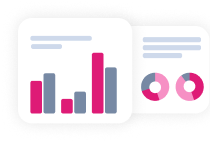Report
The new age of Gen Z
Unmasking the real lives of young adults

It’s easy to assume those closest to your age have similar life experiences. Sure, you may have started school at a similar time, but while life milestones represent moments of relatability, they neglect the unique experiences that shaped who we were at that time.
Studying demographic data alone creates broad assumptions about consumers’ attitudes, self-perceptions, and motivations. By harnessing a 360-degree view of the consumer, the balance moves from how they may be defined on paper, to the reality of individual perspectives that only syndicated research would allow us to see.
A generation isn’t defined by traditional data collection methods, so it’s time to introduce the real Gen Z.
A little disclaimer before we begin
This report doesn’t come without its sins. While we encourage marketers to think beyond demographics, the very nature of analyzing high-level Gen Z trends means we have to make some generalizations about this group – exactly what we’re suggesting you don’t do.
Nobody likes a hypocrite, so know this – we recognize the diversity of individuals, and our goal here is to highlight tendencies that provide helpful context for readers – not make definitive claims about all Gen Z consumers. Readers should avoid assumptions that all individuals align to these general trends, and use our insights for broader strategic guidance.
Key insights
Mental health matters more than you might think
Gen Z are the most likely generation to say they have a mental health condition, but also the least comfortable talking about it. Brands need to factor mental health into campaigns, as it’s becoming an issue too big to ignore.
Short-form content is (mostly) king
Gen Z took to TikTok faster than any generation, so we know they’re fans of short-form video. But in many markets, long-form videos (over 10 minutes) are just as popular, so brands need to focus on format, not just length.
Gen Z workers are quietly embracing AI
Gen Z are the most excited about AI, and many already use it regularly – even for work. This should be seen as an opportunity to embrace AI adoption with future workers native to the technology.
Target interests, passions and media preferences
Gen Z’s identity – in-person or online – isn’t shaped by their age; their hobbies, interests, values, and beliefs are what define them most. Brands profiling their audience should prioritize psychographic factors over their audience’s age, language, or gender.
Gen Z find information without a search bar
They look beyond search engines for information. Image, voice search, and AI chatbots are popular, with the latter resonating with this audience. Chatbots won’t replace traditional search, but are beneficial in enhancing the search experience online.
01
Age doesn’t define
a generation

Every generation comes with its share of stereotypes, like baby boomers being workaholics or millennials being lazy. Myths like this tend to mask the true nature of an audience, so it’s crucial to challenge these preconceptions if brands want to engage with their consumers authentically.
Based on wider research, social media posts, and general internet chatter, we’ve compiled a shortlist of the things people often associate with Gen Z, and crunched the numbers to get to the bottom of what’s fact, and what’s fiction.
Gen Z: fact vs. fiction
Most/least distinctive characteristics among Gen Z, compared to the global average
- Source: GWI Core Q3 2023
- Base: 57,996 Gen Z aged 16-26
Already a GWI user? Explore the data on the GWI platform
- Source: GWI Core Q3 2023
- Base: 57,996 Gen Z aged 16-26
Already a GWI user? Explore the data on the GWI platform
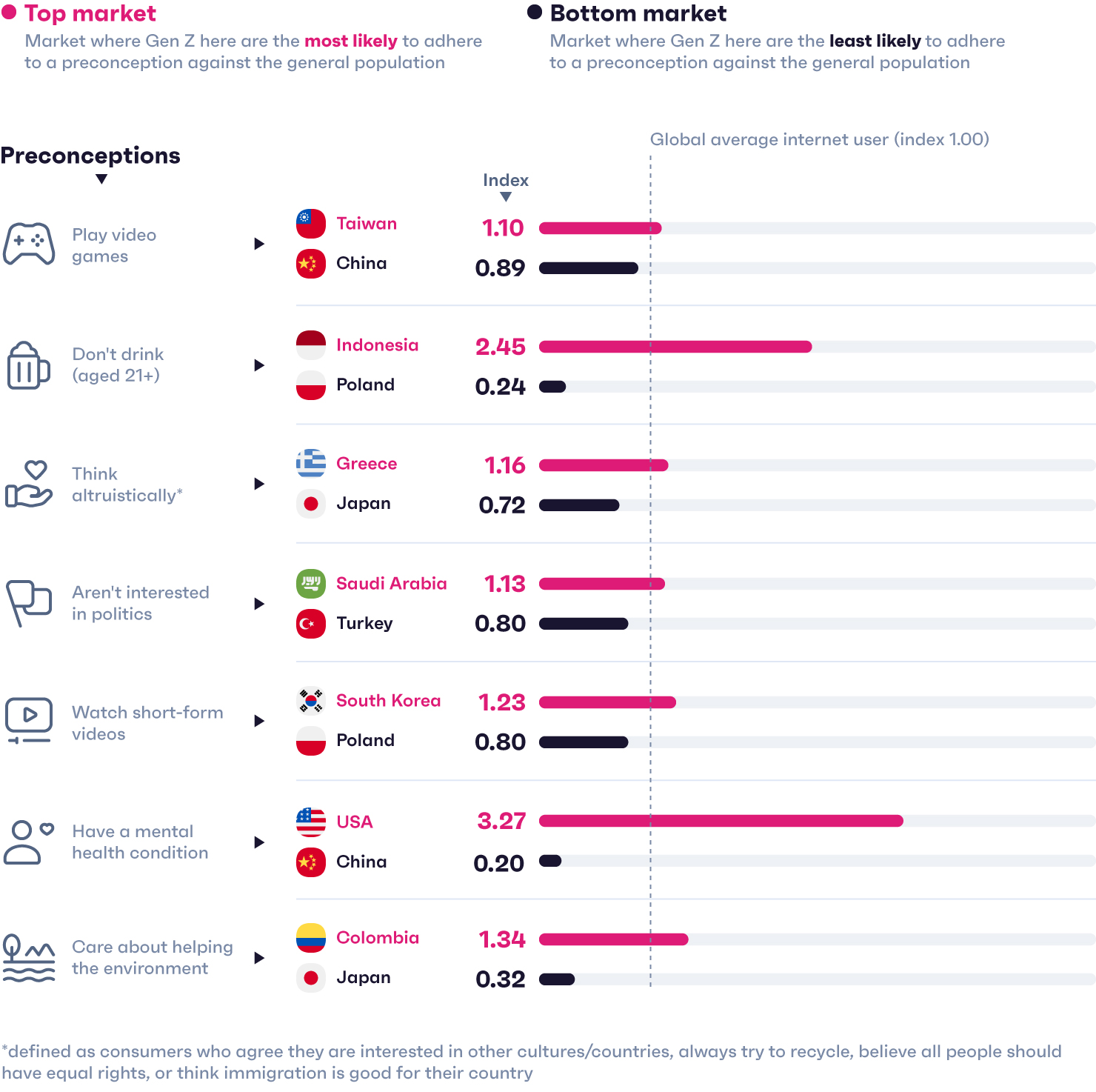
Starting with a global approach gives us a sense of what stereotypes hold up at first glance; like playing video games. Outside of China and India, Gen Z are more likely to do this, but only by 9%. So while this preconception holds up, it’s not necessarily something Gen Z are distinctly more likely to do than the rest of the world.
Then there are the things that simply don’t track, like Gen Z’s association with the word “woke”. That’s a term which is hard to define, but it’s often said this generation is more altruistic than their elders, so we looked at several data points here: do Gen Z take an interest in other countries? Do they believe in equal rights, or think immigration is good for their country? It might surprise some to hear Gen Z are actually less likely to agree with these statements.
But we need to look closer, and compare Gen Z consumers with the general population in their home country, to see if these perceptions hold up in different markets. Returning again to altruism; that’s something a lot more prevalent among Gen Z in Greece, Croatia, and Portugal, but much less likely to be the case among those in Japan, Saudi Arabia, or Egypt, for example.
There are a bunch of different ways we could slice this, but the important thing to remember is, while there might be some truth to what you hear about Gen Z, it’s rarely black and white. Our data helps brands make sense of that.
US spotlight: Mental health is on their minds

The idea that Gen Z are “more prone” to mental health issues is a fairly common stereotype, and so brands need to think carefully about their messaging.
On the surface, a lot of this adds up.
Globally, Gen Z are the most likely of any generation to say they have a mental health condition – and they’re also the least comfortable talking about it.
There’s a lot of context for why this might be. Climate change will (surely) impact them the most, Covid hit their job prospects hard, and home ownership has become something of a pipe dream.
But a lot of millennials experience these problems too. To say nothing of cultural differences either; Gen Z in markets like China, Taiwan, and Türkiye are much less likely to say they have a mental health condition, for example.
However, if there’s one market in particular where brands should bear this in mind, it’s the US. Gen Z here are, astonishingly, over three times more likely than the average to say they have a mental health condition – and 12% less likely to feel comfortable talking about it. Chalk it up to gun violence, political disparity, or something else entirely. Brands can’t afford to ignore this, so it’s important to brush up on factoring mental health into campaigns when reaching US consumers.
All grown up
With the oldest Gen Z now approaching their mid-20s, they’re getting used to working life, home ownership, marriage, and parenthood. This opens up new opportunities for brands whose products and services are being discovered by this generation for the first time – automotive, insurance, and finance are just a few examples here.
Gen Z are growing up
% of Gen Z outside China and India who are...
- Source: GWI Core 2014-2023 (avg. of waves conducted between Q1 2014 -Q3 2023)
- Base: 746,437 Gen Z outside China and India born between 1997-2007
Already a GWI user? Explore the data on the GWI platform
- Source: GWI Core 2014-2023 (avg. of waves conducted between Q1 2014 -Q3 2023)
- Base: 746,437 Gen Z outside China and India born between 1997-2007
Already a GWI user? Explore the data on the GWI platform
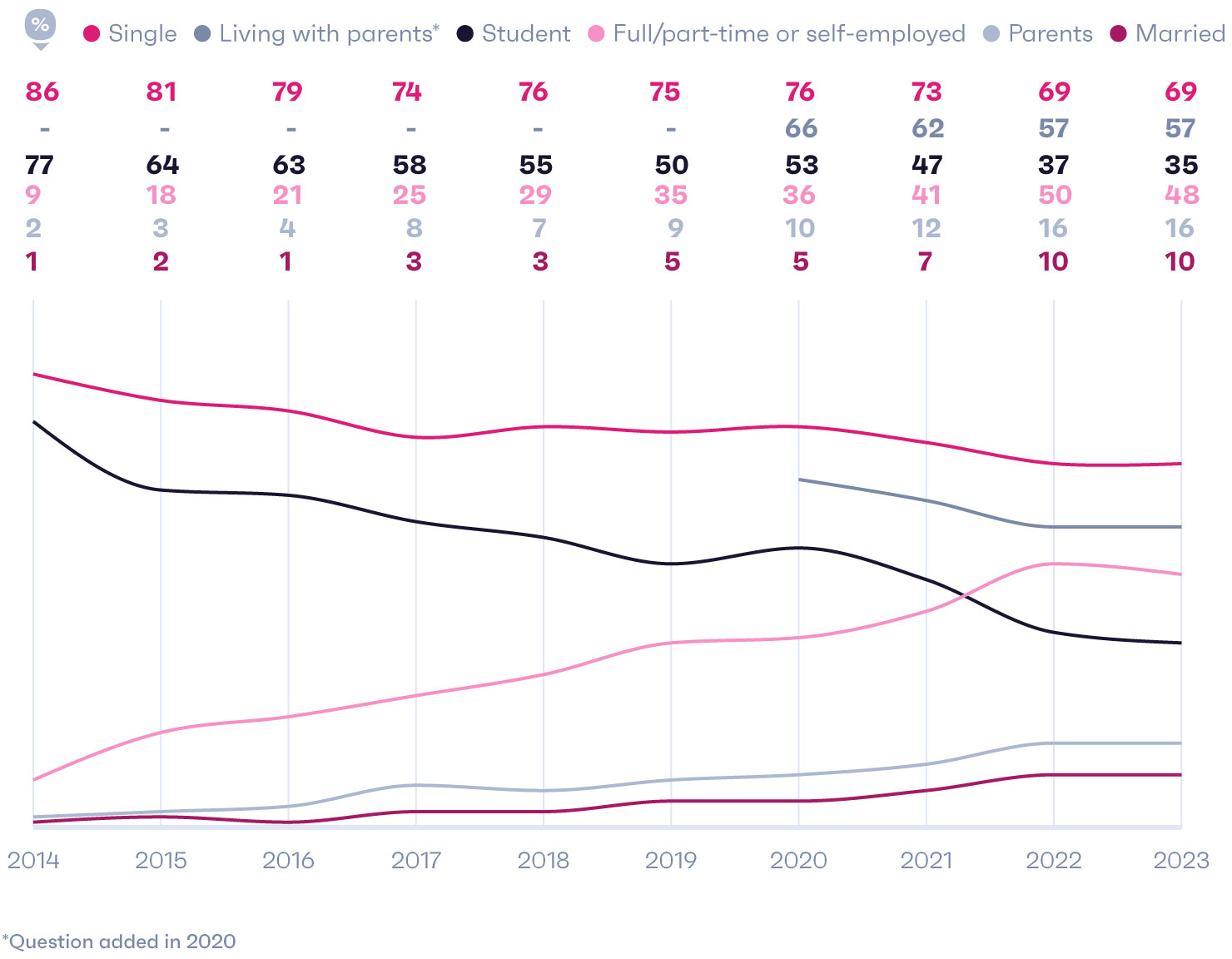
That said, life is already very different for Gen Z at either end of the spectrum; a Gen Z leaving high school has very little in common with a Gen Z working full-time. In the next 6 months, 16-21 year-olds are more likely to start dating, and while some are considering getting engaged, they’re unlikely to be getting married anytime soon. 22-26 year-olds, however, are considering leaving their current job, or even thinking about parenthood. Brands would do well to remember this, since future Gen Z consumers will behave differently down the line.
02
Engaging through entertainment

There's always time for one more game
% of Gen Z gamers outside India and China, in these groups, who in the last month have played...
- Source: GWI Gaming Q2 2023
- Base: 3,259 Gen Z aged 16-26 in 16 markets
Already a GWI user? Explore the data on the GWI platform
- Source: GWI Gaming Q2 2023
- Base: 3,259 Gen Z aged 16-26 in 16 markets
Already a GWI user? Explore the data on the GWI platform
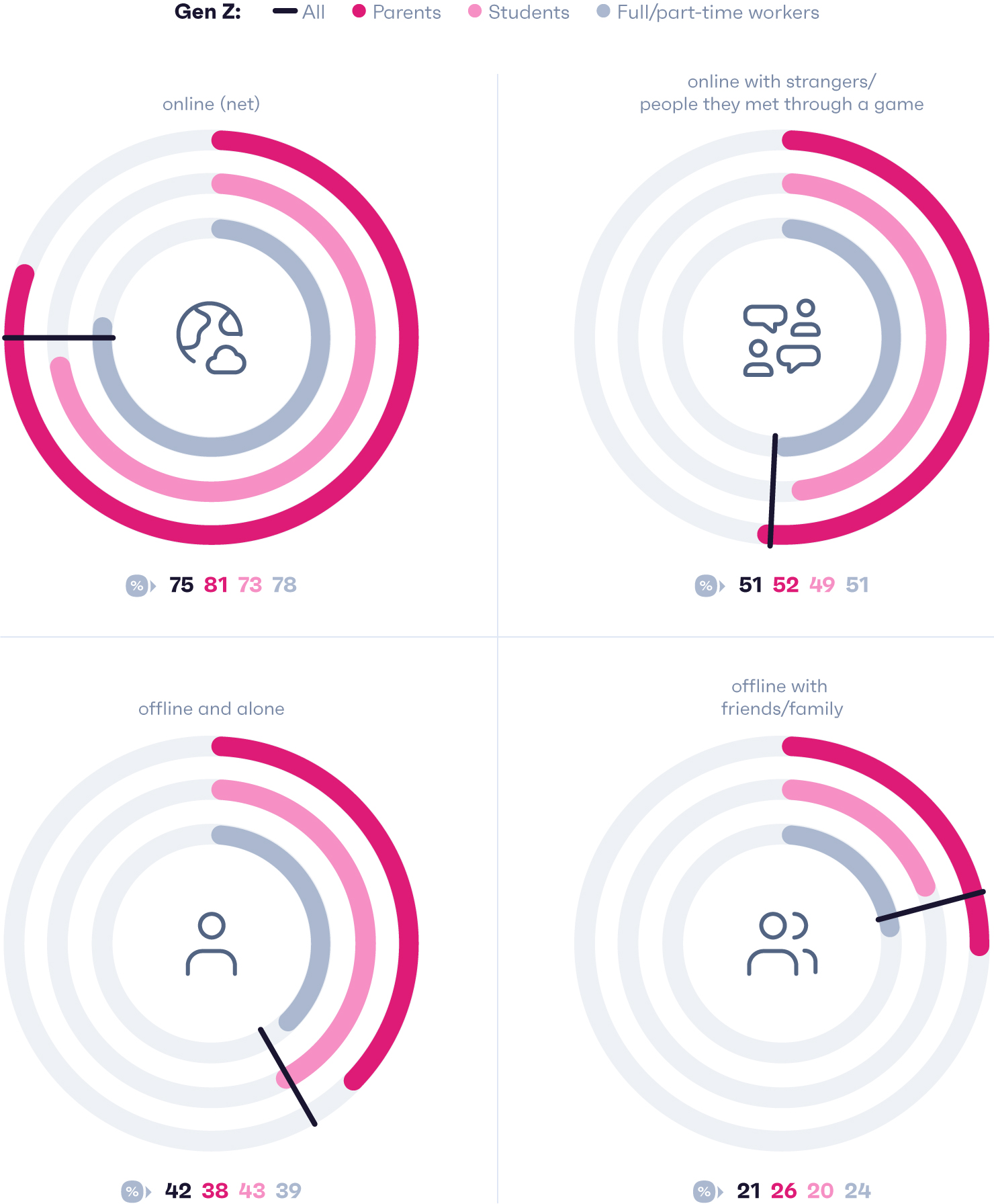
The opportunities associated with gaming should need no introduction. Influencer partnerships, advertising, sponsorship, and in-game purchases are all likely to strike a chord with this generation, but the same is true of any gaming audience. So why should this data matter to marketers? Essentially, it captures the unique way Gen Z interacts with the activity; helping inform accurate depictions of gamers in marketing campaigns.


Blog
Gaming trends for 2024
We’ve fired up our global Gaming data set on a quest to track the biggest gaming trends.
Read moreToo long; didn’t watch
Let’s set the record straight here. While Gen Z are technically less likely to watch shorter online videos (those under 10 minutes long) than the average population, there’s plenty of evidence to support the fact rapid-fire content appeals to this generation.
The evolution of viewing
% of each generation, outside China and India, who've watched the following types of TV or used the following services/platforms in the last month
- Source: GWI Core Q3 2023
- Base: 200,870 internet users aged 16-64
Already a GWI user? Explore the data on the GWI platform
- Source: GWI Core Q3 2023
- Base: 200,870 internet users aged 16-64
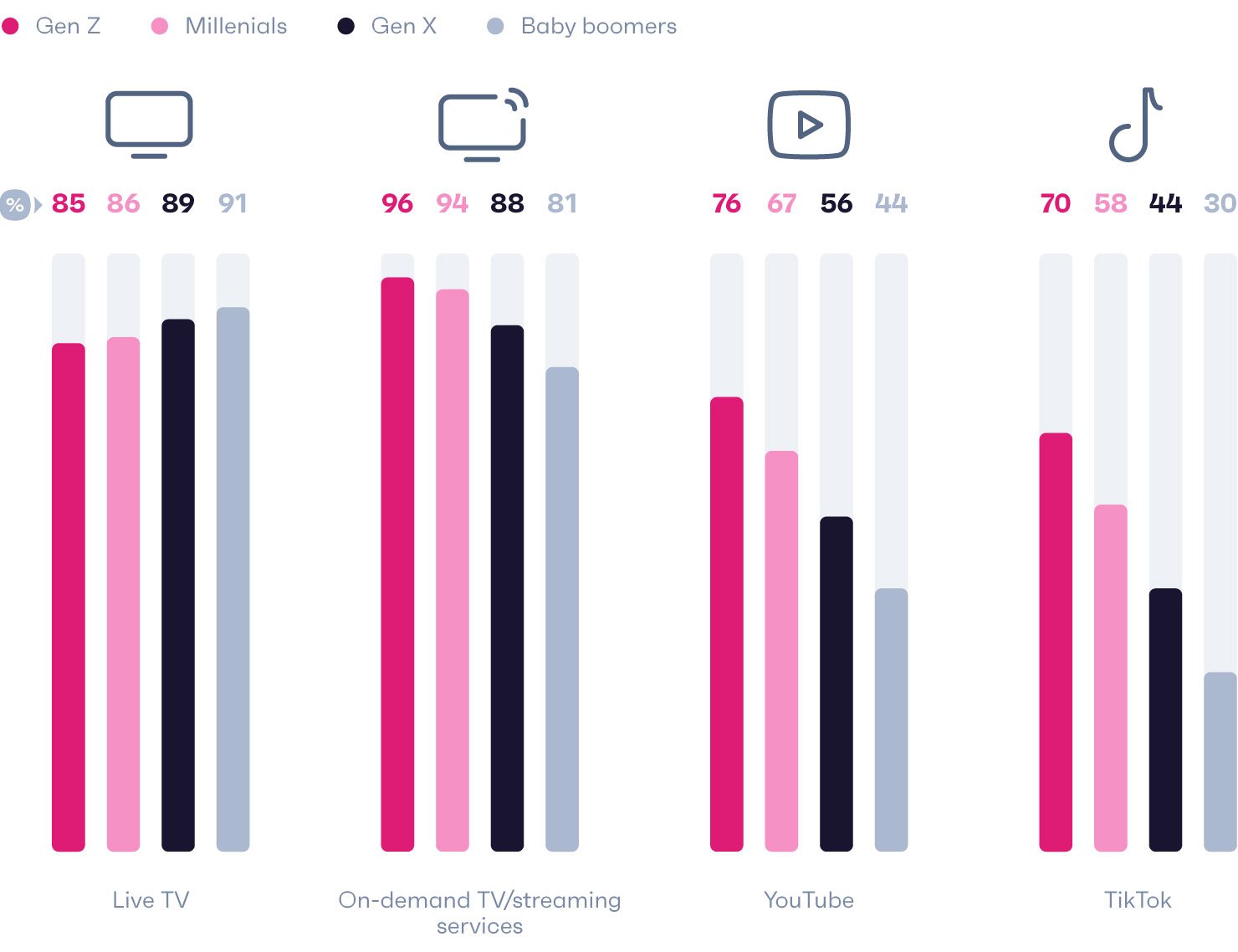
Brands are well aware of this by now, so repackaging content into more engaging, bite-size chunks has its merits when trying to reach this generation. That doesn’t rule out the impact of TV ads, but our data shows a clear preference for online formats; streaming has led against linear viewing for a while now, and YouTube (despite a 7% decline in engagement since 2021) is still more popular than any other video service we track.
What we do need to address though, is the preconception that all Gen Z have shorter attention spans. In Greece, Hong Kong, and South Korea (where shorter videos are very popular) Gen Z consumers are likely to be found watching longer videos too (those over 10 minutes long). Brands need to be aware of how engaging their content is in a crowded attention economy. Today, Gen Z product discovery favors video content over things like search engines, so it’s less about length, and more about the format.
03
Lifestyle
temperature
check

For starters, Gen Z are negotiating the transition into adulthood, embracing the experience of their newfound freedom. With this comes a balancing act between the unhealthy habits you might associate with Gen Z, and the good habits they weigh them up against, giving us a 360-degree view of their behavior.
In five European markets, Gen Z are the least likely generation to smoke cigarettes or tobacco products, which you might assume is down to health motivations. But in reality, they’re less likely than average to say they’re health-conscious, and rather than avoiding smoking altogether, they’ve taken to vaping – with over one in four saying they do.
You're more likely to find vape users following sports and drinking alcohol than studying
How much more/less likely Gen Z vapers are to say/do the following than the average Gen Z
- Source: GWI Core Q3 2023
- Base: 402 Gen Z vape users & 1,502 Gen Z consumers in France, Germany, Italy, Spain and the UK aged 18-26
- Source: GWI Core Q3 2023
- Base: 402 Gen Z vape users & 1,502 Gen Z consumers in France, Germany, Italy, Spain and the UK aged 18-26
Already a GWI user? Explore the data on the GWI platform
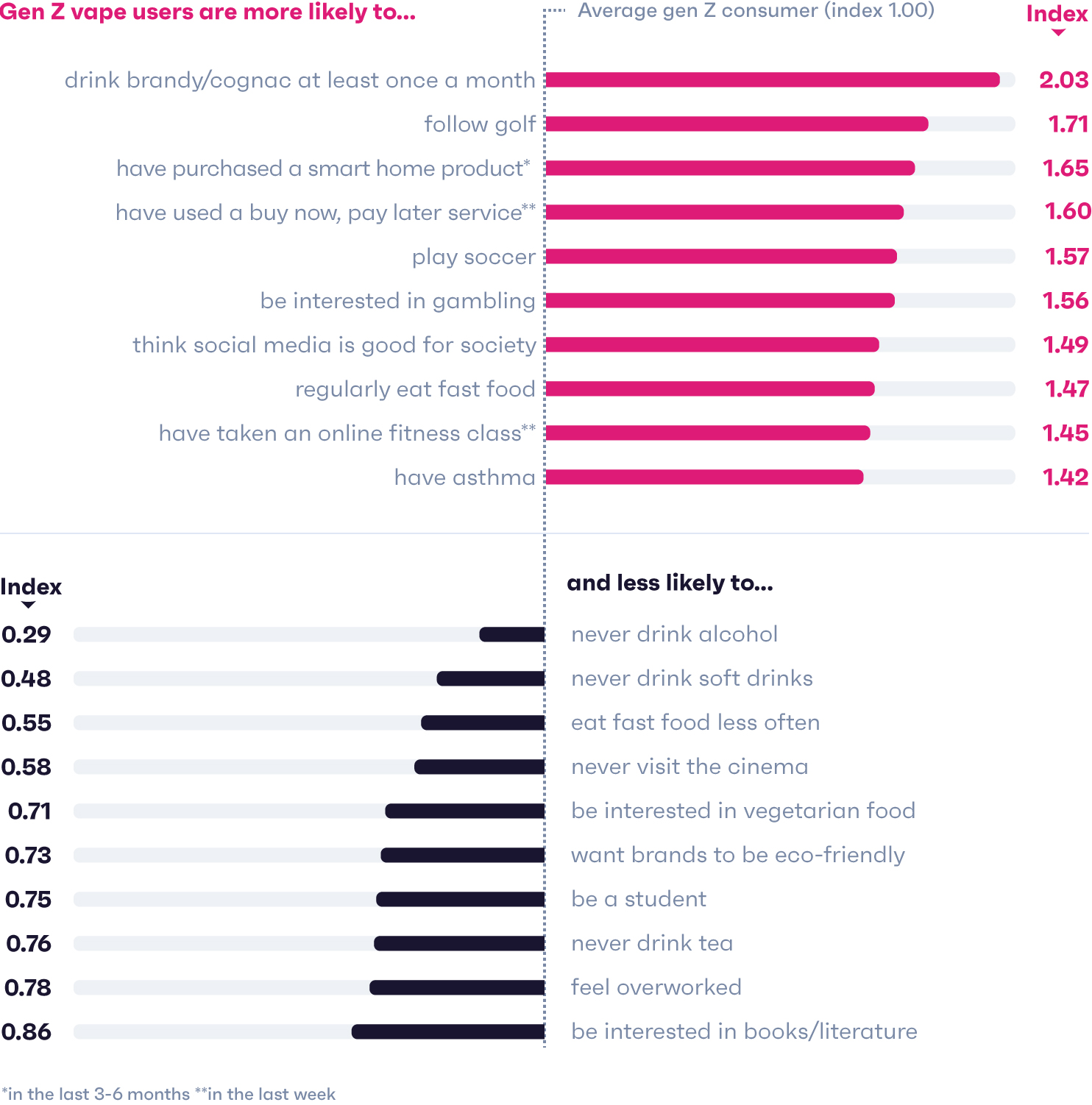

Then there’s the view that Gen Z are addicted to their phones, which to some degree, you’d be right to think. They spend more time on their phones than any other generation, with over one in four scrolling for at least six hours. It’s a lot of screentime, but even these heavy mobile users still have a health focus – not physical, but financial. These users are more likely than average to say they’re price-conscious, that they save as much money as they want to each month, and that being financially secure is important to them. When times get tough, they’ll be the first to cut back on unnecessary spending.
It’s easy to make assumptions about Gen Z behavior, but it’s outdated to think their actions aren’t well thought through. Unhealthy habits are often balanced with ‘healthy’ actions, and while easy to do, brands need to move away from preconceived ideas of how Gen Z behave.
Working 9-5, what a strain to make a living
When you think of Gen Z, you probably picture a student holed up in university accommodation, but that may be misguided. Looking at all Gen Z respondents, the number working part-time or full-time overtook the number studying at the start of 2022, with full-time working soon to be the standard among this group.
Gen Z are stepping out of student life and onto the job ladder
% of Gen Z* who say they have the following employment status/job seniority
- Source: GWI Core: 2020-2023 (avg. of all waves conducted between Q1 2020-Q3 2023)
- Base: 479,889 Gen Z consumers born between 1997-2007
Already a GWI user? Explore the data on the GWI platform
- Source: GWI Core: 2020-2023 (avg. of all waves conducted between Q1 2020-Q3 2023)
- Base: 479,889 Gen Z consumers born between 1997-2007
Already a GWI user? Explore the data on the GWI platform
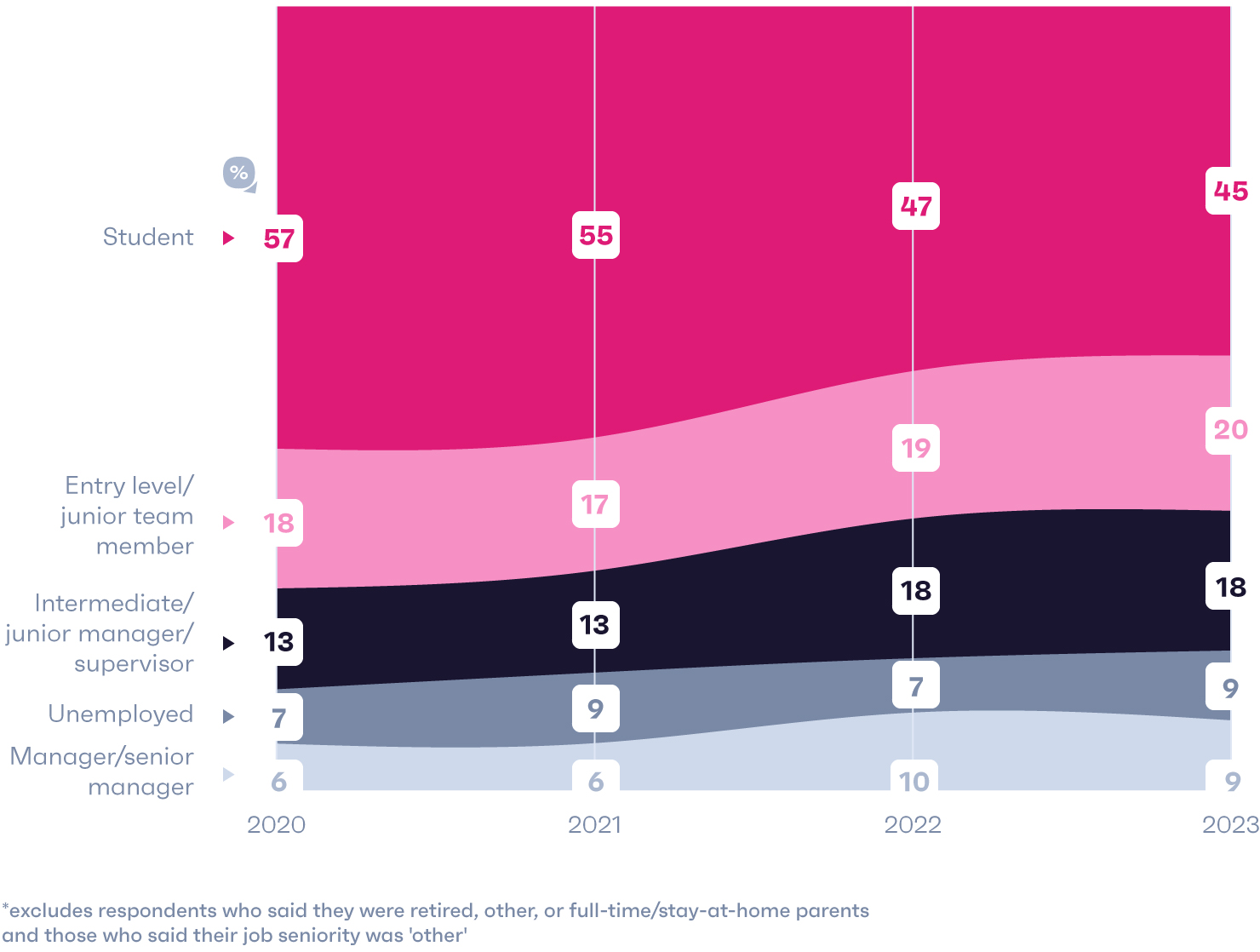
Some of the groups that stand out for feeling this way are members of the LGBTQA+ community, CBD-infused product buyers, those with a mental health or sleep-related condition, and those who say they’re suffering from migraines.
This trend isn’t driven exclusively by workplace factors, but mental health support is a workplace must-have. Despite this, only 19% of Gen Z workers say it’s a benefit they’re able to access. The knock-on effect? Those with workplace mental-health benefits are:

The Copilot coworker
With AI taking the world by storm in 2023, it’s no secret people have their concerns when it comes to using it. Our most recent Connecting the dots report clearly outlined the potential of this technology, but also the fears surrounding it.
For Gen Z, it’s much easier to communicate the positives; they’re more likely to be interested in AI overall, supportive when using it for creative projects, and agree that the technology should be allowed to operate without legal concerns. And soon enough, employers will be tasked with meeting this generation's expectations of AI in the workplace.
How AI is shaping the workplace
% of Gen Z workers who...
- Source: GWI Zeitgeist September 2023 & December 2023
- Base: 998 working Gen Z (December 2023) & 307 working Gen Z who have used ChatGPT (September 2023) in 11 markets aged 16-26
Already a GWI user? Explore the data on the GWI platform
- Source: GWI Zeitgeist September 2023 & December 2023
- Base: 998 working Gen Z (December 2023) & 307 working Gen Z who have used ChatGPT (September 2023) in 11 markets aged 16-26
Already a GWI user? Explore the data on the GWI platform
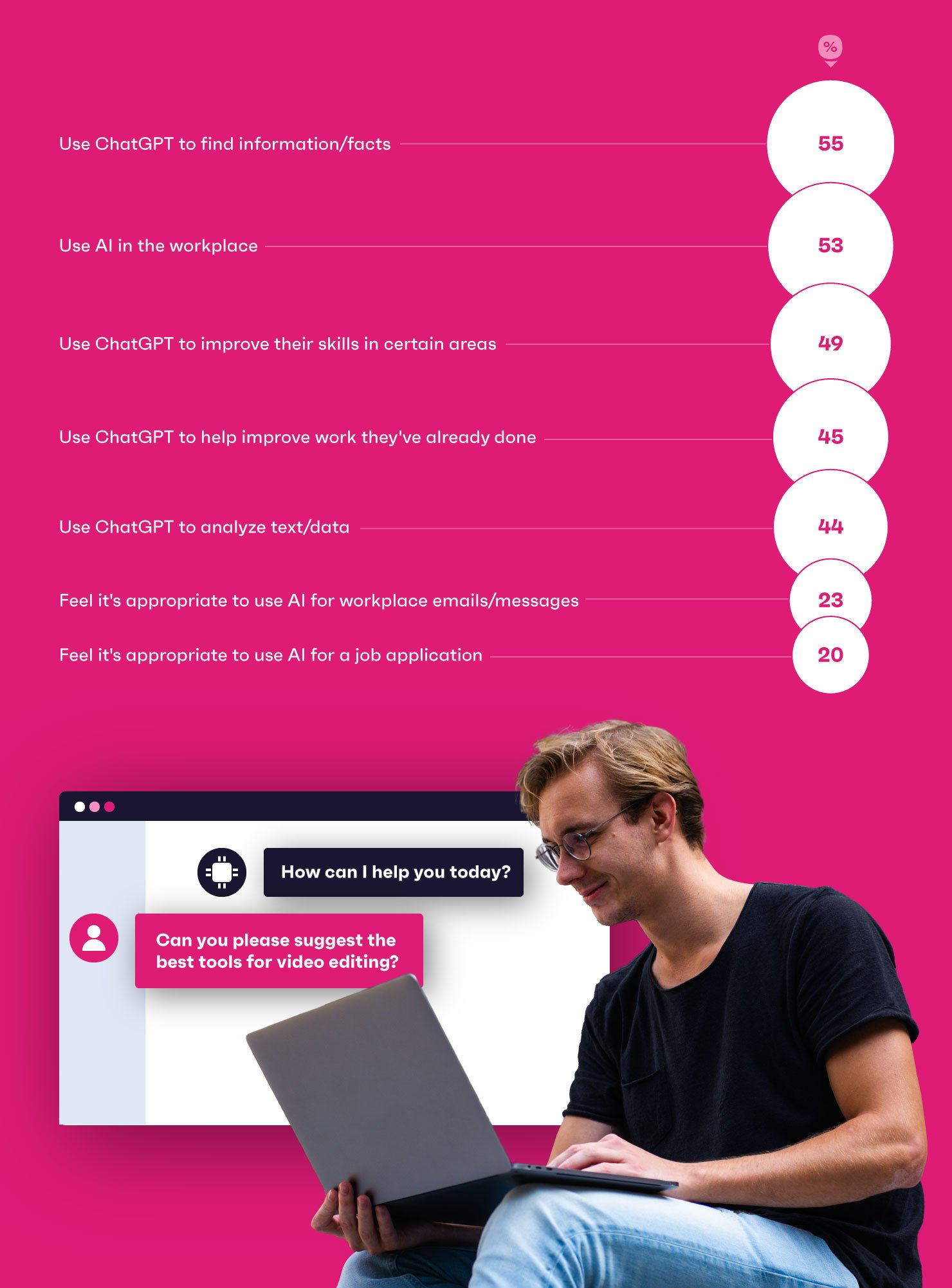
In fact, our data suggests it’s already part and parcel of the working Gen Z’s routine. Over half say they use it every month, while those in this audience who use ChatGPT say the tool’s been helpful to find information (55%), improve their skills (49%), or analyze text/data (44%). While each workplace will have its own set of rules regarding the use of AI, Gen Z’s enthusiasm for the technology represents an opportunity to keep up with both the rapidly-changing workplace landscape, and the expectations of talent among this generation.

Report
Connecting the dots 2024
AI excitement is growing, but so is concern. Understand the tension between AI fears and opportunities.
Read moreUS spotlight: Gen Z and the US(AI) election

Misinformation is already a key talking point of the upcoming US presidential election, but throw in the fact this is the first time AI will play a role in the process, and things could get a lot more confusing. There will be long-term ramifications for future generations here, so it’s really important to get an understanding of how AI could be used to better inform their final vote.
For the most part, how social media platforms tackle information will be crucial. When it comes to US Gen Z’s political influence, they’re the leading source by far; among those who’ve seen, read, or heard US political info in the last month, 2 in 3 saw such information on social media. It’s also their most trustworthy source (25% say this).
Over two thirds of US Gen Z think it’s important for media platforms to provide third-party fact checking measures on political news. Used properly, AI could be used to accomplish this, particularly since they’re more supportive of the benefits this technology provides in art, media, and the workplace.
04
A unique life online

The youngest Gen Z were born after Facebook and (then) Twitter were already signing up their first users. They’re digital natives who’ve grown up on the internet, and understanding what makes this generation unique can help brands stay ahead of the curve. One way is to look at how people present themselves online, gaining an insight into their motivations and ultimately, the opportunities they present.
Globally, 36% of social media users say they appear online as a different persona, rising to 39% among Gen Z. While you might think these younger users are hiding behind a fake profile and trolling people on the web, you’d be wide of the mark. Gen Z want to be taken seriously, and the value of a digital profile is on the up.
If we look at which social media platforms have the most users adopting different personas, you could probably give it a good guess: Reddit, X (formerly Twitter), and Instagram. But perhaps surprisingly, the biggest growth since the end of 2022 sits with LinkedIn users, which comes down to Gen Z’s growing professional ambitions.
Gen Z are investing in online personas
% change in the number of Gen Z, outside China, who adopt different personas online and say the following
- Source: GWI Core Q4 2022 & Q3 2023
- Base: 15,492 (Q4 2022) & 16,439 (Q3 2023) Gen Z social media users who adopt different personalities online born between 1997-2007
- Source: GWI Core Q4 2022 & Q3 2023
- Base: 15,492 (Q4 2022) & 16,439 (Q3 2023) Gen Z social media users who adopt different personalities online born between 1997-2007
Already a GWI user? Explore the data on the GWI platform
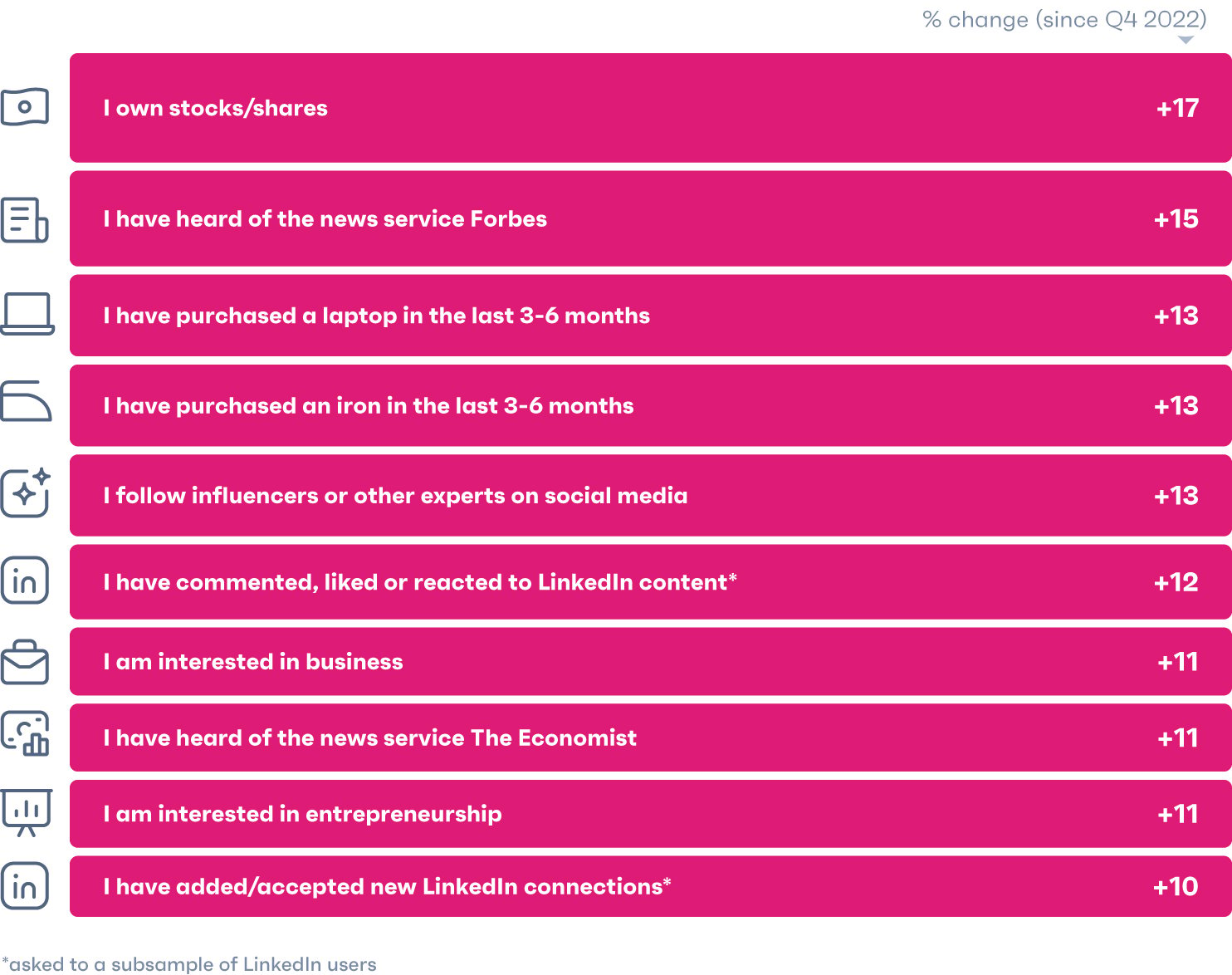
These changing digital behaviors are a result of the transition from student to working life. Getting your first job means more than just walking into the office on day one; it shapes Gen Z’s interests, the news they read, and the products they buy. It’s a shift that brands across industries need to be on the pulse of, as many could benefit by tapping into this change in lifestyle.
To understand social, understand the “why”
Social media can be used to reach all age groups, not just Gen Z. But reach only tells us so much. Looking at usage motivations is better, as they give you a much clearer picture of how social media engagement is shifting among Gen Z (and millennials, for that matter).
Ask our clients
A core part of our business is understanding new consumer behavior, and Gen Z are always a tricky generation to pin down. They've been early adopters of AI, voice search, picture search and even circle search, and they're pros on social media too. Being able to nail down what this generation are up to online, and how they're using social media platforms, is absolutely key for marketers.
Social media motivations give richer insights
% change since Q4 2020 in the number of Gen Z, outside China and India, who use these platforms for the following reasons
- Source: GWI Core Q4 2020 & Q3 2023
- Base: 27,047 (Q4 2020) & 45,915 (Q3 2023) Gen Z outside China and India aged 16-26
Already a GWI user? Explore the data on the GWI platform
- Source: GWI Core Q4 2020 & Q3 2023
- Base: 27,047 (Q4 2020) & 45,915 (Q3 2023) Gen Z outside China and India aged 16-26
Already a GWI user? Explore the data on the GWI platform
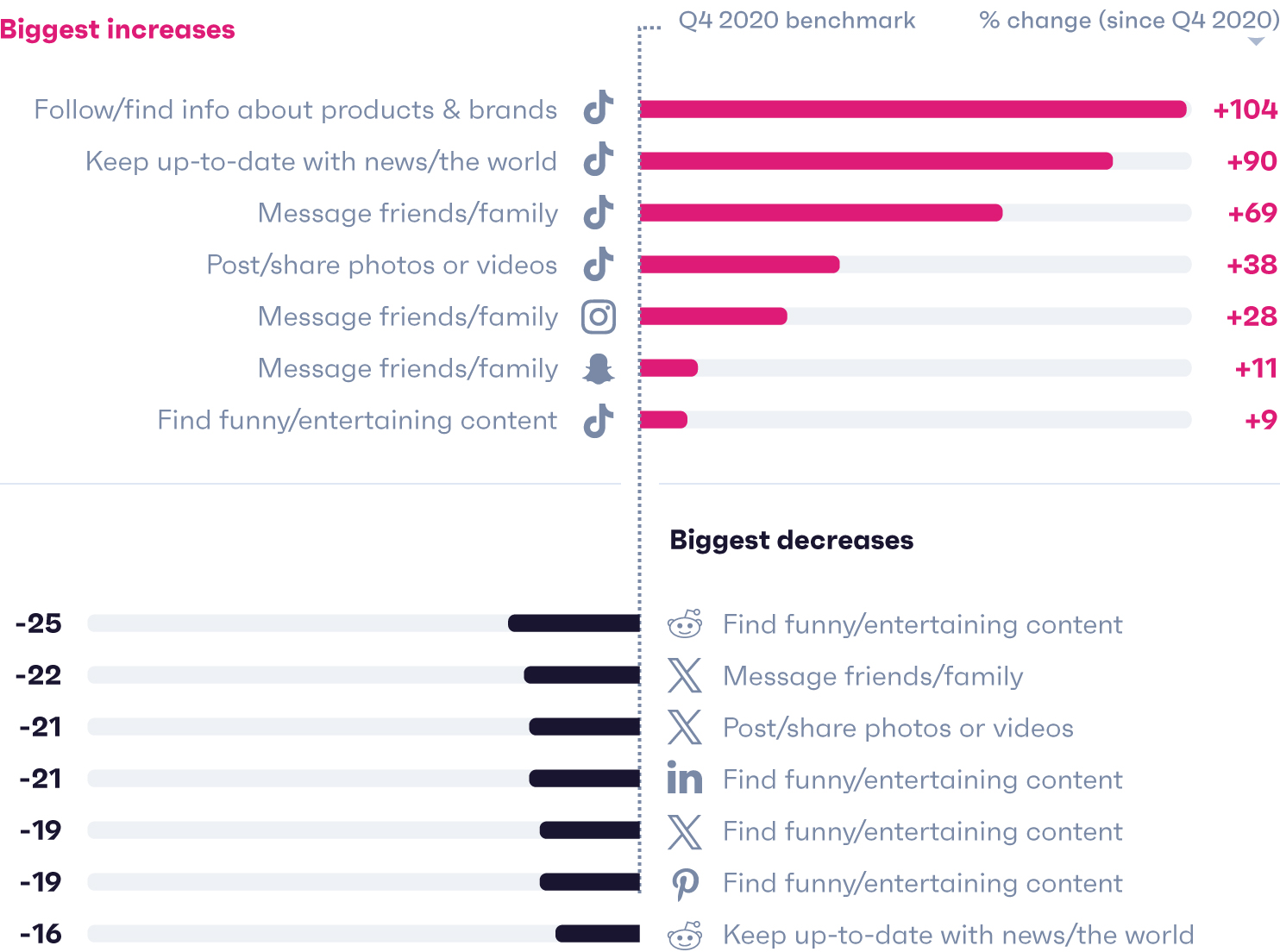
Market to me, not my demographic
If you ask Gen Z what shapes their identity, demographic factors won’t be a priority. We know, because we asked them back in April 2023. Of 25 factors surveyed, age, gender, language, and geographic location were all low on Gen Z’s list, with hobbies & interests, values & beliefs, and media & entertainment preferences firmly at the top.
The top ten factors (out of 25 surveyed) that Gen Z say most contribute to their in-person/offline identity
Rank based on the % of Gen Z that say the following most contribute to their in-person/online identity
- Source: GWI Zeitgeist April 2023
- Base: 2,041 Gen Z in 12 markets aged 16-26
Already a GWI user? Explore the data on the GWI platform
- Source: GWI Zeitgeist April 2023
- Base: 2,041 Gen Z in 12 markets aged 16-26
Already a GWI user? Explore the data on the GWI platform
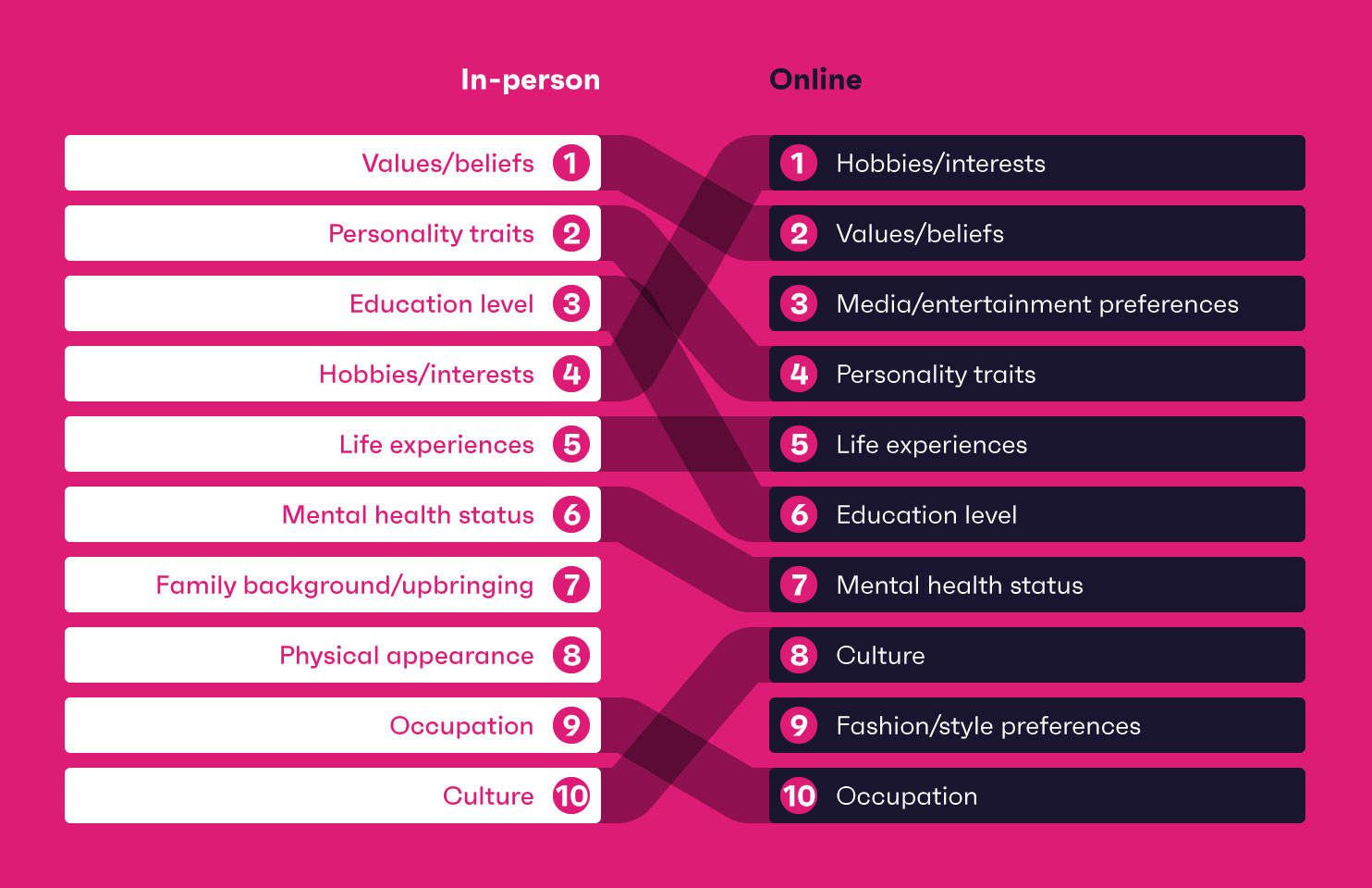
But it’s not just about how Gen Z shape their identity online, you also need to look at the information they give when signing up for services. In short, official advertising reach information from platforms will only show you part of the picture:

Nearly 2 in 5 Gen Z who’ve provided false information online say it’s to protect their privacy/identity.
APAC spotlight: Scoring digital goals with livestreaming

Of the 53 markets we surveyed in Q3 2023, Indonesia had the highest percentage of Gen Zers who said they watched live video streams in the last week (39%). It’s a highly engaged audience that speaks to a broader trend in the region, with similar interest seen in Malaysia, Vietnam, Hong Kong, and China.
Gen Z livestream viewers in APAC thrive in the digital world; whether it’s watching product review videos, clicking on sponsored ads, or even writing their own blogs or videos. If you’re a brand looking to engage, convert, and retain these consumers, they stand out from the pack for their online activities. We could highlight a number of industries here, but European football/soccer in particular presents huge opportunities.
These livestream viewers are more likely than the average Gen Z in the region to watch European competitions like the Europa League and Champions League (on TV or streaming services). They like catching up with highlights and news from the English Premier League, and playing video games like Football Manager or eFootball.
Understanding consumers’ media habits is crucial to brand exposure, and touchpoints like livestreams provide a gateway for non-domestic brands to access an engaged international audience, and a wider addressable market.
Charting Gen Z’s search behavior
If you ask consumers where they look for information, search engines have long been the most popular choice. They’re especially popular in the US, Japan, and Singapore, with over 3 in 4 saying it’s their go-to.
Today’s Gen Z are far from selective; if they want information, they’re not rushing to a search engine to find it. Social media platforms, AI chatbots/platforms, voice search, and image search take up a lot of their attention, so while search and social are crucial, brands need to focus their attention on a range of platforms.
Ask our clients
As a platform that sits at the intersection of search, social and commerce, Pinterest can enable walking the digital mall like no one else. This is even more true for Gen Z consumers, who come to Pinterest to find, save, shop, and take action on inspiring ideas. The #1 goal for Gen Z shoppers, prioritized by 9 in 10 survey respondents, is 'discovering products that fit my taste and style,' and we're constantly pushing the product forward to meet that need.

Webinar
Party on: A new generation of celebration
Settle in for an inspiring session with our experts, co-hosted with Pinterest, on how consumers are celebrating and why.
Watch nowWhile search engines are most popular, Gen Z have their own preferences
- Source: GWI Zeitgeist August 2023
- Base: 2,072 Gen Z in 12 markets aged 16-26
Already a GWI user? Explore the data on the GWI platform
- Source: GWI Zeitgeist August 2023
- Base: 2,072 Gen Z in 12 markets aged 16-26
Already a GWI user? Explore the data on the GWI platform

Clearly, the value proposition of AI search resonates most with younger adults – it achieved more in 12 months than voice and image search did in nearly a whole decade. But as we’ve shown, just because AI is the hot new technology everyone talks about, doesn’t mean its new users will abandon all their old habits. AI will complement the other search mediums, enhancing their capabilities with better personalization.

Want to unmask your audiences?
Book a no-strings-attached demo of our consumer research platform.
Book a demoNotes on methodology
All figures in this report are drawn from GWI’s online research among internet users aged 16-64, or 16+. Our figures are representative of the online populations of each market, not its total population. Note that in many markets in Latin America, the Middle-East and Africa, and the Asia-Pacific region, low internet penetration rates can mean online populations are more young, urban, affluent, and educated than the total population.
Each year, we interview over 970,000 internet users aged 16-64 in 53 markets via an online questionnaire for our Core data set. A proportion of respondents complete a shorter version of this survey via mobile, hence the sample sizes presented in the charts throughout this report may differ as some will include all respondents and others will include only respondents who completed our Core survey via PC/laptop/tablet.
When reading this report, please note that we focus on data from our ongoing global quarterly research, but also refer to our monthly Zeitgeist studies across 12 markets, and our GWI USA dataset, which surveys over 20,000 internet users in the US aged 16+ each quarter.
Throughout this report, we refer to indexes. Indexes are used to compare any given group against the average (1.00), which unless otherwise stated refers to the global average. For example, an index of “1.20” means that a given group is 20% above the global average, and an index of “0.80” means that an audience is 20% below the global average.









